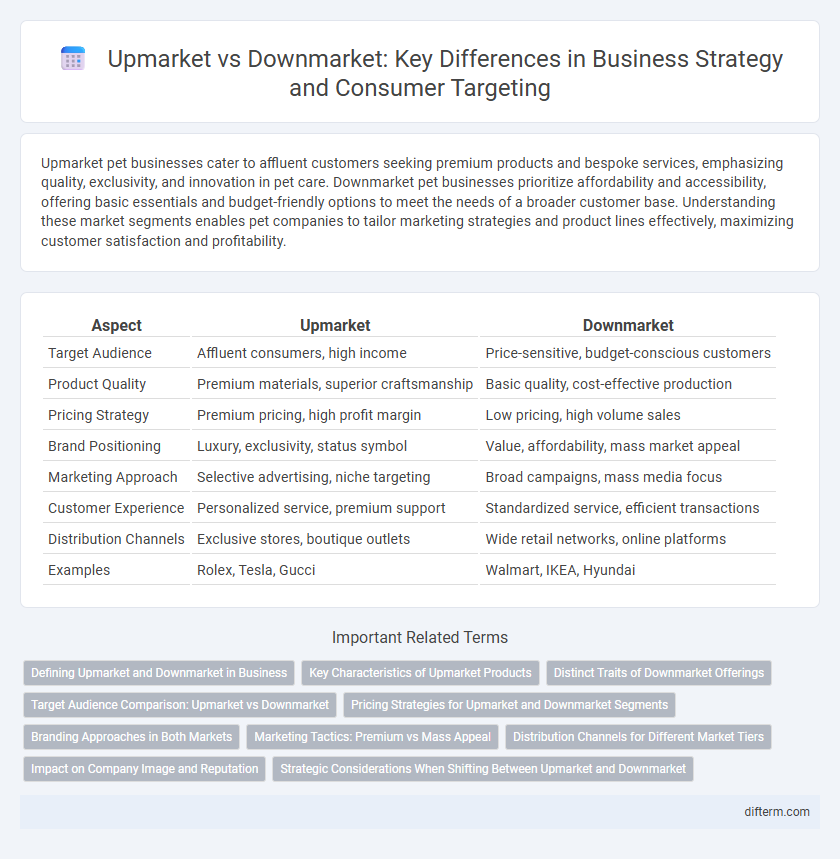Upmarket pet businesses cater to affluent customers seeking premium products and bespoke services, emphasizing quality, exclusivity, and innovation in pet care. Downmarket pet businesses prioritize affordability and accessibility, offering basic essentials and budget-friendly options to meet the needs of a broader customer base. Understanding these market segments enables pet companies to tailor marketing strategies and product lines effectively, maximizing customer satisfaction and profitability.
Table of Comparison
| Aspect | Upmarket | Downmarket |
|---|---|---|
| Target Audience | Affluent consumers, high income | Price-sensitive, budget-conscious customers |
| Product Quality | Premium materials, superior craftsmanship | Basic quality, cost-effective production |
| Pricing Strategy | Premium pricing, high profit margin | Low pricing, high volume sales |
| Brand Positioning | Luxury, exclusivity, status symbol | Value, affordability, mass market appeal |
| Marketing Approach | Selective advertising, niche targeting | Broad campaigns, mass media focus |
| Customer Experience | Personalized service, premium support | Standardized service, efficient transactions |
| Distribution Channels | Exclusive stores, boutique outlets | Wide retail networks, online platforms |
| Examples | Rolex, Tesla, Gucci | Walmart, IKEA, Hyundai |
Defining Upmarket and Downmarket in Business
Upmarket businesses target affluent consumers by offering premium products or services characterized by higher quality, exclusivity, and innovative features. Downmarket businesses focus on cost-conscious customers, providing affordable, basic, and widely accessible products with simplified features. Defining these market positions involves analyzing factors such as pricing strategies, brand perception, and consumer demographics within competitive landscapes.
Key Characteristics of Upmarket Products
Upmarket products are characterized by premium quality materials, sophisticated design, and exclusive features that justify higher price points and appeal to affluent consumers. These products often emphasize brand prestige, superior craftsmanship, and exceptional customer service to create a unique value proposition. Targeting niche markets, upmarket offerings prioritize innovation, durability, and status, differentiating themselves from mass-market or downmarket competitors.
Distinct Traits of Downmarket Offerings
Downmarket offerings typically emphasize affordability and basic functionality, targeting price-sensitive consumers seeking essential products or services. These products often feature simpler designs, lower production costs, and limited customization options to maintain competitive pricing. Brands in the downmarket sector prioritize volume sales and market penetration over premium quality or brand prestige.
Target Audience Comparison: Upmarket vs Downmarket
Upmarket brands target affluent consumers seeking premium quality, exclusivity, and superior customer experiences, often prioritizing luxury, innovation, and brand prestige. Downmarket brands focus on price-sensitive customers who prioritize affordability, accessibility, and basic functionality, catering to mass-market demand with cost-effective solutions. Understanding the distinct preferences and purchasing power of these target audiences enables businesses to tailor marketing strategies and product offerings effectively.
Pricing Strategies for Upmarket and Downmarket Segments
Upmarket pricing strategies emphasize premium pricing, leveraging high quality, exclusivity, and brand prestige to attract affluent customers willing to pay a premium. Downmarket pricing focuses on competitive, value-based pricing to capture price-sensitive segments by offering affordable products without compromising basic quality. Effective segmentation and tailored promotional tactics optimize revenue streams across both market tiers.
Branding Approaches in Both Markets
Upmarket branding emphasizes exclusivity, premium quality, and luxury, appealing to affluent consumers seeking status and unique experiences. Downmarket branding focuses on affordability, practicality, and value for money to attract price-sensitive customers and mass-market appeal. Consistent messaging tailored to each segment's expectations is crucial for building brand loyalty and positioning within competitive markets.
Marketing Tactics: Premium vs Mass Appeal
Upmarket marketing tactics emphasize exclusivity, quality, and personalized experiences to attract affluent customers willing to pay a premium for superior products or services. Downmarket strategies focus on mass appeal by highlighting affordability, accessibility, and broad availability to reach price-sensitive, wide audiences. Tailoring messaging, distribution channels, and brand positioning to target either premium niche markets or mass segments is crucial for effective marketing performance.
Distribution Channels for Different Market Tiers
Upmarket brands typically utilize exclusive distribution channels such as high-end boutiques, authorized retailers, and luxury department stores to maintain brand prestige and target affluent consumers. Downmarket products prioritize mass distribution through supermarkets, discount stores, and online marketplaces to maximize reach and affordability. Channel selection directly impacts brand positioning, customer experience, and sales performance across market tiers.
Impact on Company Image and Reputation
Upmarket positioning enhances a company's image by associating the brand with luxury, quality, and exclusivity, attracting discerning customers and fostering customer loyalty. Downmarket strategies can broaden market reach and volume but risk diluting brand prestige and may lead to perceptions of lower quality or value. Maintaining a consistent brand identity is crucial to preserve reputation and avoid confusion among target audiences in both upmarket and downmarket segments.
Strategic Considerations When Shifting Between Upmarket and Downmarket
Shifting between upmarket and downmarket segments requires precise strategic considerations including brand positioning, customer value perception, and pricing models. Upmarket transitions emphasize premium quality, exclusivity, and enhanced customer experience to justify higher price points, while downmarket shifts focus on cost efficiency, broader accessibility, and volume-driven sales. Companies must align product development, marketing strategies, and supply chain operations to effectively meet the expectations and demands of the targeted market segment.
upmarket vs downmarket Infographic

 difterm.com
difterm.com